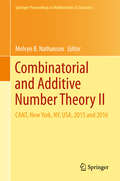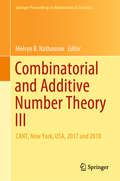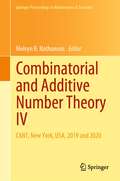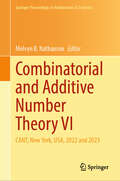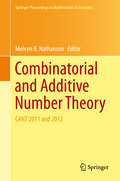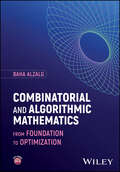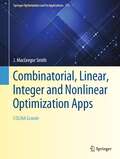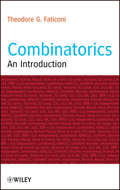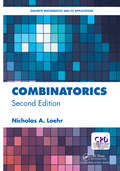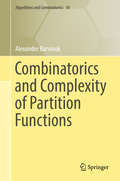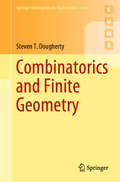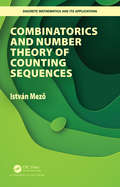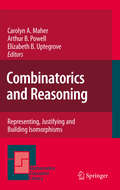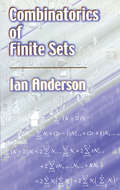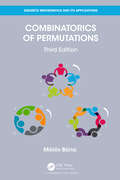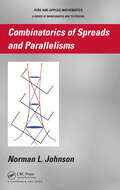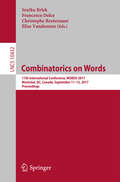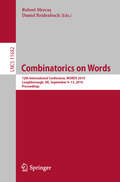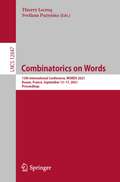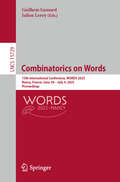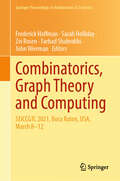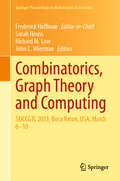- Table View
- List View
Combinatorial and Additive Number Theory II: CANT, New York, NY, USA, 2015 and 2016 (Springer Proceedings in Mathematics & Statistics #220)
by Melvyn B. NathansonBased on talks from the 2015 and 2016 Combinatorial and Additive Number Theory (CANT) workshops at the City University of New York, these proceedings offer 19 peer-reviewed and edited papers on current topics in number theory. Held every year since 2003, the workshop series surveys state-of-the-art open problems in combinatorial and additive number theory and related parts of mathematics. Sumsets, partitions, convex polytopes and discrete geometry, Ramsey theory, primality testing, and cryptography are among the topics featured in this volume. Each contribution is dedicated to a specific topic that reflects the latest results by experts in the field. Researchers and graduate students interested in the current progress in number theory will find this selection of articles relevant and compelling.
Combinatorial and Additive Number Theory III: CANT, New York, USA, 2017 and 2018 (Springer Proceedings in Mathematics & Statistics #297)
by Melvyn B. NathansonBased on talks from the 2017 and 2018 Combinatorial and Additive Number Theory (CANT) workshops at the City University of New York, these proceedings offer 17 peer-reviewed and edited papers on current topics in number theory. Held every year since 2003, the workshop series surveys state-of-the-art open problems in combinatorial and additive number theory and related parts of mathematics. Topics featured in this volume include sumsets, partitions, convex polytopes and discrete geometry, Ramsey theory, commutative algebra and discrete geometry, and applications of logic and nonstandard analysis to number theory. Each contribution is dedicated to a specific topic that reflects the latest results by experts in the field. This selection of articles will be of relevance to both researchers and graduate students interested in current progress in number theory.
Combinatorial and Additive Number Theory IV: CANT, New York, USA, 2019 and 2020 (Springer Proceedings in Mathematics & Statistics #347)
by Melvyn B. NathansonThis is the fourth in a series of proceedings of the Combinatorial and Additive Number Theory (CANT) conferences, based on talks from the 2019 and 2020 workshops at the City University of New York. The latter was held online due to the COVID-19 pandemic, and featured speakers from North and South America, Europe, and Asia. The 2020 Zoom conference was the largest CANT conference in terms of the number of both lectures and participants.These proceedings contain 25 peer-reviewed and edited papers on current topics in number theory. Held every year since 2003 at the CUNY Graduate Center, the workshop surveys state-of-the-art open problems in combinatorial and additive number theory and related parts of mathematics. Topics featured in this volume include sumsets, zero-sum sequences, minimal complements, analytic and prime number theory, Hausdorff dimension, combinatorial and discrete geometry, and Ramsey theory. This selection of articles will be of relevance to both researchers and graduate students interested in current progress in number theory.
Combinatorial and Additive Number Theory VI: CANT, New York, USA, 2022 and 2023 (Springer Proceedings in Mathematics & Statistics #464)
by Melvyn B. NathansonThis proceedings volume, the sixth in a series from the Combinatorial and Additive Number Theory (CANT) conferences, is based on talks from the 20th and 21st annual workshops, held in New York in 2022 (virtual) and 2023 (hybrid) respectively. Organized every year since 2003 by the New York Number Theory Seminar at the CUNY Graduate Center, the workshops survey state-of-the-art open problems in combinatorial and additive number theory and related parts of mathematics. In this volume, the reader will find peer-reviewed and edited papers on current topics in number theory. This selection of articles will be of relevance to both researchers and graduate students interested in current progress in number theory.
Combinatorial and Additive Number Theory: CANT 2011 and 2012 (Springer Proceedings in Mathematics & Statistics #101)
by Melvyn B. NathansonThis proceedings volume is based on papers presented at the Workshops on Combinatorial and Additive Number Theory (CANT), which were held at the Graduate Center of the City University of New York in 2011 and 2012. The goal of the workshops is to survey recent progress in combinatorial number theory and related parts of mathematics. The workshop attracts researchers and students who discuss the state-of-the-art, open problems and future challenges in number theory.
Combinatorial and Algorithmic Mathematics: From Foundation to Optimization
by Baha AlzalgDetailed review of optimization from first principles, supported by rigorous math and computer science explanations and various learning aids Supported by rigorous math and computer science foundations, Combinatorial and Algorithmic Mathematics: From Foundation to Optimization provides a from-scratch understanding to the field of optimization, discussing 70 algorithms with roughly 220 illustrative examples, 160 nontrivial end-of-chapter exercises with complete solutions to ensure readers can apply appropriate theories, principles, and concepts when required, and Matlab codes that solve some specific problems. This book helps readers to develop mathematical maturity, including skills such as handling increasingly abstract ideas, recognizing mathematical patterns, and generalizing from specific examples to broad concepts. Starting from first principles of mathematical logic, set-theoretic structures, and analytic and algebraic structures, this book covers both combinatorics and algorithms in separate sections, then brings the material together in a final section on optimization. This book focuses on topics essential for anyone wanting to develop and apply their understanding of optimization to areas such as data structures, algorithms, artificial intelligence, machine learning, data science, computer systems, networks, and computer security. Combinatorial and Algorithmic Mathematics includes discussion on: Propositional logic and predicate logic, set-theoretic structures such as sets, relations, and functions, and basic analytic and algebraic structures such as sequences, series, subspaces, convex structures, and polyhedraRecurrence-solving techniques, counting methods, permutations, combinations, arrangements of objects and sets, and graph basics and propertiesAsymptotic notations, techniques for analyzing algorithms, and computational complexity of various algorithmsLinear optimization and its geometry and duality, simplex and non-simplex algorithms for linear optimization, second-order cone programming, and semidefinite programming Combinatorial and Algorithmic Mathematics is an ideal textbook resource on the subject for students studying discrete structures, combinatorics, algorithms, and optimization. It also caters to scientists across diverse disciplines that incorporate algorithms and academics and researchers who wish to better understand some modern optimization methodologies.
Combinatorial, Linear, Integer and Nonlinear Optimization Apps: COLINA Grande (Springer Optimization and Its Applications #175)
by J. MacGregor SmithThis textbook provides an introduction to the use and understanding of optimization and modeling for upper-level undergraduate students in engineering and mathematics. The formulation of optimization problems is founded through concepts and techniques from operations research: Combinatorial Optimization, Linear Programming, and Integer and Nonlinear Programming (COLIN). Computer Science (CS) is also relevant and important given the applications of algorithms and Apps/algorithms (A) in solving optimization problems. Each chapter provides an overview of the main concepts of optimization according to COLINA, providing examples through App Inventor and AMPL software applications. All apps developed through the text are available for download. Additionally, the text includes links to the University of Wisconsin NEOS server, designed to handle more computing-intensive problems in complex optimization. Readers are encouraged to have some background in calculus, linear algebra, and related mathematics.
Combinatorics
by Theodore G.FaticoniBridges combinatorics and probability and uniquely includes detailed formulas and proofs to promote mathematical thinking Combinatorics: An Introduction introduces readers to counting combinatorics, offers examples that feature unique approaches and ideas, and presents case-by-case methods for solving problems. Detailing how combinatorial problems arise in many areas of pure mathematics, most notably in algebra, probability theory, topology, and geometry, this book provides discussion on logic and paradoxes; sets and set notations; power sets and their cardinality; Venn diagrams; the multiplication principal; and permutations, combinations, and problems combining the multiplication principal. Additional features of this enlightening introduction include: Worked examples, proofs, and exercises in every chapter Detailed explanations of formulas to promote fundamental understanding Promotion of mathematical thinking by examining presented ideas and seeing proofs before reaching conclusions Elementary applications that do not advance beyond the use of Venn diagrams, the inclusion/exclusion formula, the multiplication principal, permutations, and combinations Combinatorics: An Introduction is an excellent book for discrete and finite mathematics courses at the upper-undergraduate level. This book is also ideal for readers who wish to better understand the various applications of elementary combinatorics.
Combinatorics (Discrete Mathematics and Its Applications)
by Nicholas Loehr<p>Combinatorics, Second Edition is a well-rounded, general introduction to the subjects of enumerative, bijective, and algebraic combinatorics. The textbook emphasizes bijective proofs, which provide elegant solutions to counting problems by setting up one-to-one correspondences between two sets of combinatorial objects. The author has written the textbook to be accessible to readers without any prior background in abstract algebra or combinatorics. <p>Part I of the second edition develops an array of mathematical tools to solve counting problems: basic counting rules, recursions, inclusion-exclusion techniques, generating functions, bijective proofs, and linear algebraic methods. These tools are used to analyze combinatorial structures such as words, permutations, subsets, functions, graphs, trees, lattice paths, and much more. Part II cover topics in algebraic combinatorics including group actions, permutation statistics, symmetric functions, and tableau combinatorics. <p>This edition provides greater coverage of the use of ordinary and exponential generating functions as a problem-solving tool. Along with two new chapters, several new sections, and improved exposition throughout, the textbook is brimming with many examples and exercises of various levels of difficulty.</p>
Combinatorics and Complexity of Partition Functions (Algorithms and Combinatorics #30)
by Alexander BarvinokPartition functions arise in combinatorics and related problems of statistical physics as they encode in a succinct way the combinatorial structure of complicated systems. The main focus of the book is on efficient ways to compute (approximate) various partition functions, such as permanents, hafnians and their higher-dimensional versions, graph and hypergraph matching polynomials, the independence polynomial of a graph and partition functions enumerating 0-1 and integer points in polyhedra, which allows one to make algorithmic advances in otherwise intractable problems. The book unifies various, often quite recent, results scattered in the literature, concentrating on the three main approaches: scaling, interpolation and correlation decay. The prerequisites include moderate amounts of real and complex analysis and linear algebra, making the book accessible to advanced math and physics undergraduates.
Combinatorics and Finite Geometry (Springer Undergraduate Mathematics Series)
by Steven T. DoughertyThis undergraduate textbook is suitable for introductory classes in combinatorics and related topics. The book covers a wide range of both pure and applied combinatorics, beginning with the very basics of enumeration and then going on to Latin squares, graphs and designs. The latter topic is closely related to finite geometry, which is developed in parallel. Applications to probability theory, algebra, coding theory, cryptology and combinatorial game theory comprise the later chapters. Throughout the book, examples and exercises illustrate the material, and the interrelations between the various topics is emphasized. Readers looking to take first steps toward the study of combinatorics, finite geometry, design theory, coding theory, or cryptology will find this book valuable. Essentially self-contained, there are very few prerequisites aside from some mathematical maturity, and the little algebra required is covered in the text. The book is also a valuable resource for anyone interested in discrete mathematics as it ties together a wide variety of topics.
Combinatorics and Number Theory of Counting Sequences (Discrete Mathematics and Its Applications)
by Istvan MezoCombinatorics and Number Theory of Counting Sequences is an introduction to the theory of finite set partitions and to the enumeration of cycle decompositions of permutations. The presentation prioritizes elementary enumerative proofs. Therefore, parts of the book are designed so that even those high school students and teachers who are interested in combinatorics can have the benefit of them. Still, the book collects vast, up-to-date information for many counting sequences (especially, related to set partitions and permutations), so it is a must-have piece for those mathematicians who do research on enumerative combinatorics. In addition, the book contains number theoretical results on counting sequences of set partitions and permutations, so number theorists who would like to see nice applications of their area of interest in combinatorics will enjoy the book, too. Features The Outlook sections at the end of each chapter guide the reader towards topics not covered in the book, and many of the Outlook items point towards new research problems. An extensive bibliography and tables at the end make the book usable as a standard reference. Citations to results which were scattered in the literature now become easy, because huge parts of the book (especially in parts II and III) appear in book form for the first time.
Combinatorics and Reasoning: Representing, Justifying and Building Isomorphisms (Mathematics Education Library #47)
by Elizabeth B. Uptegrove Carolyn A. Maher Arthur B. PowellCombinatorics and Reasoning: Representing, Justifying and Building Isomorphisms is based on the accomplishments of a cohort group of learners from first grade through high school and beyond, concentrating on their work on a set of combinatorics tasks. By studying these students, the editors gain insight into the foundations of proof building, the tools and environments necessary to make connections, activities to extend and generalize combinatoric learning, and even explore implications of this learning on the undergraduate level. This volume underscores the power of attending to basic ideas in building arguments; it shows the importance of providing opportunities for the co-construction of knowledge by groups of learners; and it demonstrates the value of careful construction of appropriate tasks. Moreover, it documents how reasoning that takes the form of proof evolves with young children and discusses the conditions for supporting student reasoning.
Combinatorics of Finite Sets (Dover Books on Mathematics)
by Ian AndersonCoherent treatment provides comprehensive view of basic methods and results of the combinatorial study of finite set systems. The Clements-Lindstrom extension of the Kruskal-Katona theorem to multisets is explored, as is the Greene-Kleitman result concerning k-saturated chain partitions of general partially ordered sets. Connections with Dilworth's theorem, the marriage problem, and probability are also discussed. Each chapter ends with a helpful series of exercises and outline solutions appear at the end. "An excellent text for a topics course in discrete mathematics." -- Bulletin of the American Mathematical Society.
Combinatorics of Permutations (Discrete Mathematics and Its Applications)
by Miklos BonaA CHOICE "Outstanding Academic Title," the first edition of this bestseller was lauded for its detailed yet engaging treatment of permutations. Providing more than enough material for a one-semester course, Combinatorics of Permutations, third edition continues to clearly show the usefulness of this subject for both students and researchers. The research in combinatorics of permutations has advanced rapidly since this book was published in a first edition. Now the third edition offers not only updated results, it remains the leading textbook for a course on the topic. Coverage is mostly enumerative, but there are algebraic, analytic, and topological parts as well, and applications. Since the publication of the second edition, there is tremendous progress in pattern avoidance (Chapters 4 and 5). There is also significant progress in the analytic combinatorics of permutations, which will be incorporated. •A completely new technique from extremal combinatorics disproved a long-standing conjecture, and this is presented in Chapter 4. •The area of universal permutations has undergone a lot of very recent progress, and that has been noticed outside the academic community as well. This also influenced the revision of Chapter 5. •New results in stack sorting are added to Chapter 8. •Chapter 9 applications to biology has been revised. The author’s other works include Introduction to Enumerative and Analytic Combinatorics, second edition (CHOICE "Outstanding Academic Title") and Handbook of Enumerative Combinatorics, published by CRC Press. The author also serves as Series Editor for CRC’s Discrete Mathematics and Its Applications.
Combinatorics of Spreads and Parallelisms (Chapman & Hall Pure and Applied Mathematics)
by Norman JohnsonCombinatorics of Spreads and Parallelisms covers all known finite and infinite parallelisms as well as the planes comprising them. It also presents a complete analysis of general spreads and partitions of vector spaces that provide groups enabling the construction of subgeometry partitions of projective spaces.The book describes general partitions
Combinatorics on Words: 11th International Conference, WORDS 2017, Montréal, QC, Canada, September 11-15, 2017, Proceedings (Lecture Notes in Computer Science #10432)
by Christophe Reutenauer Srečko Brlek Francesco Dolce Élise VandommeThe two parts of this text are based on two series of lectures delivered by Jean Berstel and Christophe Reutenauer in March 2007 at the Centre de Recherches Mathematiques, Montreal, Canada. Part I represents the first modern and comprehensive exposition of the theory of Christoffel words. Part II presents numerous combinatorial and algorithmic aspects of repetition-free words stemming from the work of Axel Thue--a pioneer in the theory of combinatorics on words. A beginner to the theory of combinatorics on words will be motivated by the numerous examples, and the large variety of exercises, which make the book unique at this level of exposition. The clean and streamlined exposition and the extensive bibliography will also be appreciated. After reading this book, beginners should be ready to read modern research papers in this rapidly growing field and contribute their own research to its development. Experienced readers will be interested in the finitary approach to Sturmian words that Christoffel words offer, as well as the novel geometric and algebraic approach chosen for their exposition. They will also appreciate the historical presentation of the Thue-Morse word and its applications, and the novel results on Abelian repetition-free words.
Combinatorics on Words: 12th International Conference, WORDS 2019, Loughborough, UK, September 9–13, 2019, Proceedings (Lecture Notes in Computer Science #11682)
by Robert Mercaş Daniel ReidenbachThis book constitutes the refereed proceedings of the 12th International Conference on Combinatorics on Words, WORDS 2019, held in Loughborough, UK, in September 2019. The 21 revised full papers presented in this book together with 5 invited talks were carefully reviewed and selected from 34 submissions. WORDS is the main conference series devoted to the mathematical theory of words. In particular, the combinatorial, algebraic and algorithmic aspects of words are emphasized. Motivations may also come from other domains such as theoretical computer science, bioinformatics, digital geometry, symbolic dynamics, numeration systems, text processing, number theory, etc.
Combinatorics on Words: 13th International Conference, WORDS 2021, Rouen, France, September 13–17, 2021, Proceedings (Lecture Notes in Computer Science #12847)
by Thierry Lecroq Svetlana PuzyninaThis book constitutes the refereed proceedings of the 13th International Conference on Combinatorics on Words, WORDS 2021, held virtually in September 2021. The 14 revised full papers presented in this book together with 2 invited talks were carefully reviewed and selected from 18 submissions. WORDS is the main conference series devoted to the mathematical theory of words. In particular, the combinatorial, algebraic and algorithmic aspects of words are emphasized. Motivations may also come from other domains such as theoretical computer science, bioinformatics, digital geometry, symbolic dynamics, numeration systems, text processing, number theory, etc.
Combinatorics on Words: 15th International Conference, WORDS 2025, Nancy, France, June 30 – July 4, 2025, Proceedings (Lecture Notes in Computer Science #15729)
by Julien Leroy Guilhem GamardThis book constitutes the refereed proceedings of the 15th International Conference on Combinatorics on Words, WORDS 2025, held in Nancy, France, during June 30– July 4, 2025. The 20 papers included in these proceedings were carefully reviewed and selected from 31 submissions. They focus on mathematical theory of words. In particular, the combinatorial, algebraic and algorithmic aspects of words are emphasized.
Combinatorics, Automata and Number Theory
by Valérie Berthé Michel RigoThis collaborative 2010 volume presents trends arising from the fruitful interaction between the themes of combinatorics on words, automata and formal language theory, and number theory. Presenting several important tools and concepts, the authors also reveal some of the exciting and important relationships that exist between these different fields. Topics include numeration systems, word complexity function, morphic words, Rauzy tilings and substitutive dynamical systems, Bratelli diagrams, frequencies and ergodicity, Diophantine approximation and transcendence, asymptotic properties of digital functions, decidability issues for D0L systems, matrix products and joint spectral radius. Topics are presented in a way that links them to the three main themes, but also extends them to dynamical systems and ergodic theory, fractals, tilings and spectral properties of matrices. Graduate students, research mathematicians and computer scientists working in combinatorics, theory of computation, number theory, symbolic dynamics, fractals, tilings and stringology will find much of interest in this book.
Combinatorics, Graph Theory and Computing: SEICCGTC 2021, Boca Raton, USA, March 8–12 (Springer Proceedings in Mathematics & Statistics #448)
by Sarah Holliday Frederick Hoffman Zvi Rosen Farhad Shahrokhi John WiermanThis proceedings volume convenes selected, revised papers presented at the 52nd Southeastern International Conference on Combinatorics, Graph Theory and Computing (SEICCGTC 2021), virtually held at Florida Atlantic University in Boca Raton, USA, on March 8-12, 2021. As has been a tradition since its inception in 1970, this edition once more brought together mathematicians, practitioners, and scientists around novel findings in combinatorics, graph theory and computing, and their interactions.The lectures and works presented at the Conference have proven to be of great interest to other scientists and analysts employing these mathematical sciences in their professional activities in business, industry, and government. Such an environment promotes a better understanding of the roles of modern applied mathematics, combinatorics, and computer science. Many works have demonstrated that disciplines have increasingly contributed to each other. With this series of Conferences, the gaps between the fields tend to decrease even further.This volume is of particular interest for the community of pure and applied mathematicians in academia, industry, and government, working in combinatorics and graph theory, as well as related areas of computer science and the interactions among these fields. Its findings can also benefit a general audience of practitioners and students from related fields.
Combinatorics, Graph Theory and Computing: SEICCGTC 2022, Boca Raton, USA, March 7–11 (Springer Proceedings in Mathematics & Statistics #462)
by Frederick HoffmanThis proceedings volume compiles selected, revised papers presented at the 53rd SouthEastern International Conference on Combinatorics, Graph Theory, and Computing (SEICCGTC 2022), which took place at Florida Atlantic University in Boca Raton, USA, from March 7th to 11th, 2022. The SEICCGTC is widely regarded as a trendsetter for other conferences worldwide. Many ideas and themes initially discussed here have subsequently been explored in other conferences and symposia. Since 1970, the conference has been held annually in Baton Rouge, Louisiana, and Boca Raton, Florida. Over the years, it has grown to become the primary annual conference in its fields, playing a crucial role in disseminating results and fostering collaborative work. This volume is tailored for the community of pure and applied mathematicians in academia, industry, and government, who work in combinatorics and graph theory, as well as related areas of computer science and the intersections among these fields.
Combinatorics, Graph Theory and Computing: SEICCGTC 2023, Boca Raton, USA, March 6–10 (Springer Proceedings in Mathematics & Statistics #489)
by Frederick HoffmanThis proceedings volume compiles selected, revised papers presented at the 54th Southeastern International Conference on Combinatorics, Graph Theory, and Computing (SEICCGTC 2023), which took place at Florida Atlantic University in Boca Raton, USA, from March 6th to 10th, 2023. The SEICCGTC is widely regarded as a trendsetter for other conferences worldwide. Many ideas and themes initially discussed here have subsequently been explored in other conferences and symposia. Since 1970, the conference has been held annually in Baton Rouge, Louisiana, and Boca Raton, Florida. Over the years, it has grown to become the primary annual conference in its fields, playing a crucial role in disseminating results and fostering collaborative work. This volume is tailored for the community of pure and applied mathematicians in academia, industry, and government, who work in combinatorics and graph theory, as well as related areas of computer science and the intersections among these fields.
Combinatorics, Words and Symbolic Dynamics
by Valérie Berthé Michel RigoInternationally recognised researchers look at developing trends in combinatorics with applications in the study of words and in symbolic dynamics. They explain the important concepts, providing a clear exposition of some recent results, and emphasise the emerging connections between these different fields. Topics include combinatorics on words, pattern avoidance, graph theory, tilings and theory of computation, multidimensional subshifts, discrete dynamical systems, ergodic theory, numeration systems, dynamical arithmetics, automata theory and synchronised words, analytic combinatorics, continued fractions and probabilistic models. Each topic is presented in a way that links it to the main themes, but then they are also extended to repetitions in words, similarity relations, cellular automata, friezes and Dynkin diagrams. The book will appeal to graduate students, research mathematicians and computer scientists working in combinatorics, theory of computation, number theory, symbolic dynamics, tilings and stringology. It will also interest biologists using text algorithms.
